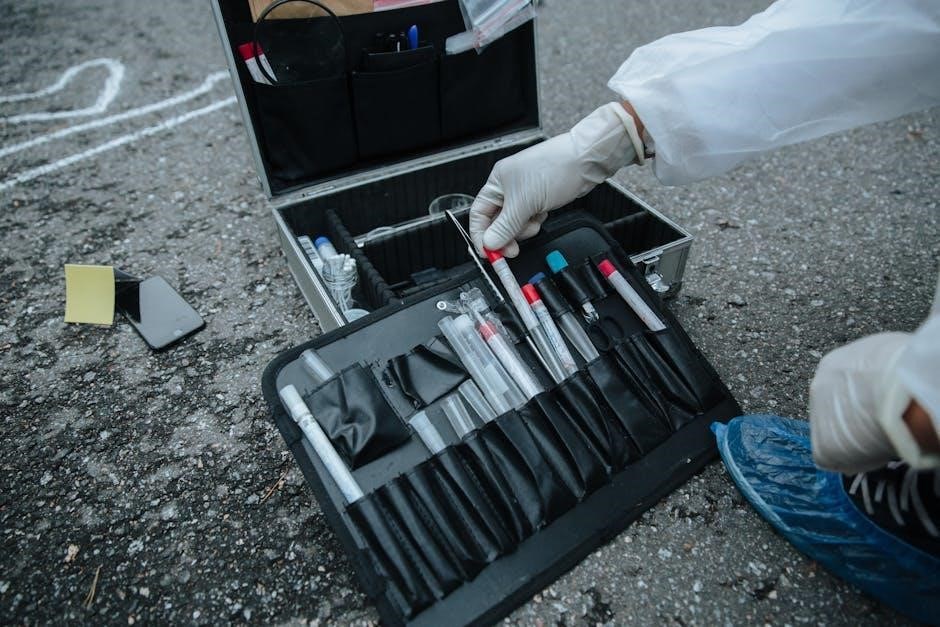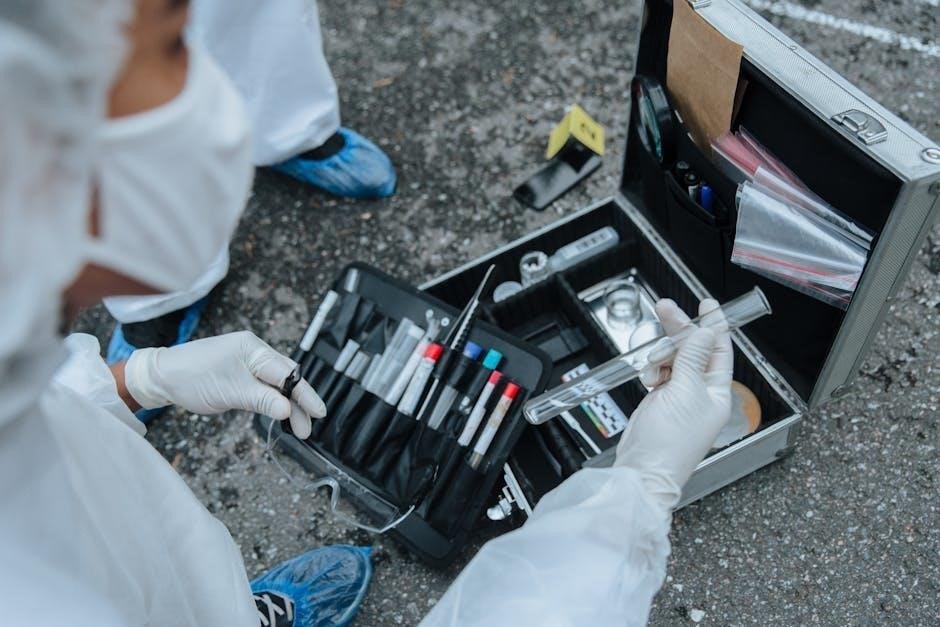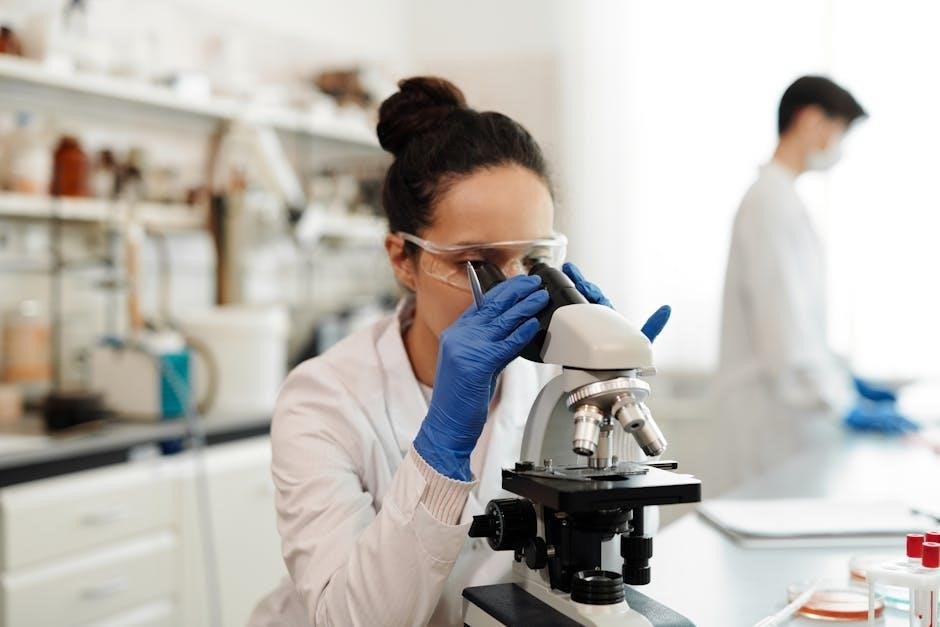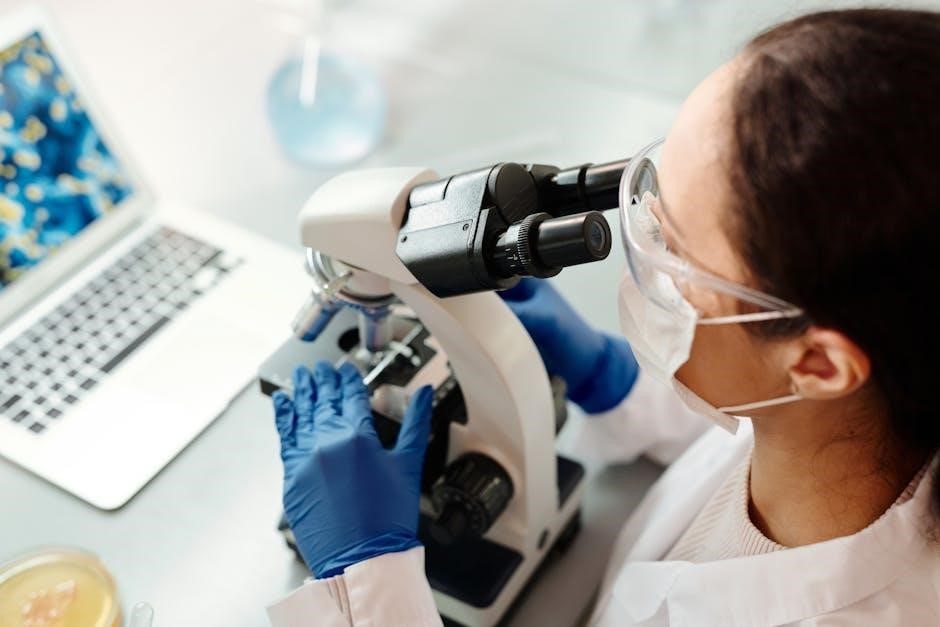forensic science fundamentals and investigations pdf
Fundamentals of Forensic Science
The textbook Forensic Science: Fundamentals and Investigations provides a comprehensive introduction to key principles, methods, and applications of forensic science. It balances scientific concepts with hands-on activities, case studies, and real-world examples, offering practical insights for students and professionals alike.
With tools like MindTap and interactive labs, it engages learners in active problem-solving, ensuring a deep understanding of forensic techniques. This resource is essential for building a strong foundation in forensic science and its investigative practices.
Forensic science is the application of scientific principles to legal issues, playing a critical role in criminal investigations. It involves the analysis of physical evidence to establish facts and solve crimes. The textbook Forensic Science: Fundamentals and Investigations provides a clear introduction to this field, covering basic concepts and methodologies. Designed for high school and undergraduate students, it offers a balanced approach, blending theory with practical applications. The book emphasizes hands-on learning through lab activities, case studies, and real-world scenarios, making complex scientific principles accessible. By integrating biology, chemistry, physics, and mathematics, it prepares students for careers in forensic science. Additionally, it highlights the importance of ethical considerations and the impact of forensic science on society. With its comprehensive coverage and engaging format, the text serves as an essential resource for understanding the fundamentals of forensic science and its investigative practices.
1.2 Key Principles of Forensic Science

The foundation of forensic science rests on several key principles that ensure the accuracy and reliability of its methods. The Forensic Science: Fundamentals and Investigations textbook outlines these principles, emphasizing the importance of objectivity, integrity, and scientific rigor. One central principle is the concept of Locard’s Exchange Principle, which states that every contact between two objects leaves a trace, providing a basis for evidence analysis. Another critical principle is the Chain of Custody, which ensures the integrity of evidence from collection to presentation in court. Additionally, the principle of Individualization highlights the uniqueness of physical evidence, allowing forensic scientists to link items to specific individuals or events. These principles, along with the use of validated scientific methods and continuous professional development, form the cornerstone of modern forensic science, guiding investigators to uncover the truth and support the justice system effectively.
1.3 Branches of Forensic Science
Forensic science encompasses a wide range of specialized disciplines, each addressing specific types of evidence and legal questions. The Forensic Science: Fundamentals and Investigations textbook highlights key branches, including forensic biology, which focuses on DNA analysis and biological fluids, and forensic chemistry, which examines substances like drugs, explosives, and toxins. Another critical branch is forensic physics, which applies physical principles to analyze evidence such as fingerprints, bullets, and tire tracks. Additionally, digital forensics has emerged as a vital field, dealing with the recovery and analysis of electronic data from devices like computers and smartphones. Other branches include forensic pathology, which investigates the cause of death, and forensic psychology, which evaluates mental states in criminal cases. These diverse branches collectively provide a comprehensive approach to solving crimes and resolving legal disputes, showcasing the interdisciplinary nature of forensic science.
1.4 Historical Development

The evolution of forensic science is rooted in ancient practices and has grown significantly over centuries. Early civilizations, such as the Chinese and Greeks, laid the groundwork by documenting methods for solving crimes. The Forensic Science: Fundamentals and Investigations textbook traces this journey, highlighting milestones like the use of fingerprints in ancient China and the development of toxicology in the 19th century. The 20th century saw transformative advancements, including the discovery of DNA profiling by Alec Jeffreys in 1984, which revolutionized criminal investigations. Digital forensics emerged later, addressing modern crimes involving technology. These historical developments underscore the continuous adaptation of forensic science to new challenges, ensuring its role as a cornerstone in criminal justice systems.
1.5 Importance in Criminal Justice
Forensic science plays a pivotal role in criminal justice by providing objective, scientific evidence to investigate and resolve crimes. Its methodologies ensure the integrity of evidence, linking suspects to crime scenes and exonerating the innocent. Through advancements like DNA profiling and digital forensics, forensic science enhances the accuracy of criminal investigations, aiding law enforcement in solving complex cases. The Forensic Science: Fundamentals and Investigations textbook emphasizes how these techniques strengthen legal proceedings, ensuring justice is served. By bridging science and law, forensic science upholds the integrity of the criminal justice system, fostering public trust and accountability. Its contributions are indispensable in modern legal frameworks, making it a cornerstone of fair and reliable justice.

Crime Scene Investigations

Crime scene investigations are critical in gathering evidence, ensuring its integrity, and reconstructing events. Techniques like evidence collection, documentation, and preservation are vital for maintaining justice and solving crimes effectively.
2.1 Processing the Crime Scene
Processing the crime scene involves systematic steps to ensure evidence is preserved and collected accurately. It begins with securing the area to prevent contamination and documenting every detail through photographs, sketches, and notes. Investigators then identify, collect, and label physical evidence, such as fingerprints, DNA, or weapons, using specialized tools. Digital forensics may also be employed to recover data from electronic devices. The process requires meticulous attention to detail to maintain the integrity of evidence and ensure its admissibility in court. Proper protocols are followed to avoid cross-contamination and preserve the chain of custody. This phase is crucial for reconstructing events and solving crimes effectively. The textbook Forensic Science: Fundamentals and Investigations provides hands-on activities and case studies to illustrate these procedures, emphasizing the importance of precision and legal standards in crime scene processing.
2.2 Evidence Collection Techniques
Evidence collection techniques are critical in forensic science to ensure the integrity and reliability of evidence. These methods include dusting for fingerprints, swabbing for DNA, and lifting footprints, each requiring specialized tools and chemicals. Proper documentation and labeling are essential to maintain the chain of custody. The use of gloves, masks, and sterile equipment prevents contamination. Digital tools, like 3D scanners, are increasingly used to capture precise crime scene details. The textbook Forensic Science: Fundamentals and Investigations provides detailed guidance through hands-on activities and case studies, highlighting the importance of meticulous protocols in evidence collection for successful criminal investigations.
2.3 Preservation of Evidence
Preservation of evidence is a cornerstone of forensic science, ensuring the integrity of collected evidence from contamination or degradation. Proper techniques include storing evidence in sterile, tamper-proof containers and maintaining optimal environmental conditions. Moisture, light, and temperature fluctuations can compromise evidence, so specialized storage solutions are employed. DNA evidence, for instance, is preserved in cool, dry environments to prevent degradation. The textbook Forensic Science: Fundamentals and Investigations outlines detailed protocols for evidence preservation, emphasizing the importance of meticulous documentation to maintain the chain of custody. These practices are critical for ensuring the admissibility of evidence in court and supporting accurate forensic analysis. By adhering to strict preservation standards, forensic professionals safeguard the reliability of evidence, which is essential for fair and just criminal proceedings.
2.4 Documentation Methods
Accurate and thorough documentation is a critical aspect of crime scene investigations. It ensures that all evidence and observations are recorded systematically for future reference. The textbook Forensic Science: Fundamentals and Investigations highlights various methods, including written notes, photographs, sketches, and video recordings. These tools capture every detail, from the position of evidence to environmental conditions. Standardized forms and checklists are often used to maintain consistency and prevent oversight. Proper documentation also supports the chain of custody, ensuring that evidence is traceable and admissible in court. Additionally, digital tools and software, such as case management systems, are increasingly employed to enhance documentation efficiency and accuracy. These methods collectively contribute to the integrity and reliability of forensic investigations, making documentation an indispensable step in the process. By adhering to rigorous documentation standards, investigators ensure that all findings are credible and actionable.
2.5 Importance of Crime Scene Investigation

Crime scene investigation (CSI) is pivotal in solving crimes by identifying, collecting, and analyzing physical evidence. It provides a factual foundation for criminal investigations, linking suspects to crimes and exonerating the innocent. Through meticulous documentation and evidence preservation, CSI ensures the integrity of findings, making them admissible in court. This process aids legal proceedings by providing objective data, helping jurors understand complex cases. Moreover, CSI deters criminal activity by demonstrating the effectiveness of forensic methods; Public trust in law enforcement is strengthened when investigations are thorough and transparent. The textbook Forensic Science: Fundamentals and Investigations emphasizes these principles, highlighting how CSI directly impacts justice and public safety. By systematically uncovering the truth, crime scene investigators play a crucial role in maintaining law and order within society.

Forensic DNA Typing
Forensic DNA typing is a cornerstone of modern forensic science, enabling the identification of individuals through unique genetic markers. The process involves analyzing specific DNA sequences to match profiles, aiding in criminal investigations and resolving paternity disputes.
Forensic DNA typing is a revolutionary tool in criminal investigations, enabling the identification of individuals through unique genetic markers. By analyzing specific DNA sequences, forensic scientists can match profiles from crime scenes to suspects or victims. This method relies on the uniqueness of DNA profiles, ensuring high accuracy in identifying individuals. DNA typing has become a cornerstone in forensic science due to its reliability and ability to resolve crimes that might otherwise remain unsolved. It also plays a critical role in exonerating the wrongly accused and confirming guilt in criminal cases. The process involves extracting DNA from biological samples, such as blood or saliva, and comparing it to known profiles. Advances in DNA technology have enhanced the speed and precision of typing, making it indispensable in modern forensic investigations. This technique has significantly impacted the field, providing a scientific basis for justice and truth in legal proceedings.
3.2 The DNA Typing Process
The DNA typing process involves several critical steps to identify and analyze genetic material. First, DNA is extracted from biological samples, such as blood, saliva, or tissue, using specialized chemicals. Next, specific regions of the DNA, known as short tandem repeats (STRs), are amplified through polymerase chain reaction (PCR). These STRs are highly variable among individuals, making them ideal for identification. The amplified DNA is then separated and analyzed using techniques like capillary electrophoresis, which sorts fragments by size. Finally, the resulting DNA profile is compared to known samples or stored in databases for matching. This process ensures accurate identification of individuals, playing a vital role in criminal investigations and resolving cases. The precision of DNA typing has made it a cornerstone of modern forensic science, providing reliable evidence in legal proceedings. By following these steps, forensic scientists can conclusively link DNA evidence to individuals, aiding in justice and truth.

3.3 Applications in Forensic Science
DNA typing has revolutionized forensic science, offering precise identification and analysis in criminal investigations. Its primary application is in identifying human remains, resolving paternity disputes, and solving crimes by matching DNA profiles from crime scenes to suspects or victims. DNA evidence is also used to exonerate wrongly convicted individuals and confirm the identity of missing persons. Additionally, DNA typing aids in historical investigations, such as identifying remains of deceased individuals or solving cold cases. The technology is also applied in wildlife forensics to combat illegal trafficking of endangered species. By providing irrefutable links between biological samples and individuals, DNA typing has become a cornerstone of modern forensic science, enhancing justice and accuracy in legal proceedings. Its versatility and reliability make it an indispensable tool for investigators worldwide, ensuring that truth and accountability are upheld in various scenarios. This widespread use underscores the critical role of DNA typing in advancing forensic capabilities.

3.4 Challenges in DNA Analysis
DNA analysis, despite its reliability, faces several challenges in forensic science. Contamination during sample collection or handling can lead to misleading results, undermining the integrity of investigations. Degraded DNA, often found in aged or poorly preserved samples, limits the ability to obtain clear profiles. Additionally, mixed DNA samples from multiple individuals complicate analysis, requiring advanced techniques to isolate and identify individual profiles. Legal and ethical concerns, such as privacy issues and the potential for misuse of genetic data, also pose significant challenges. Furthermore, the interpretation of DNA evidence requires specialized expertise, and errors in interpretation can lead to wrongful convictions. Technological limitations, such as the inability to analyze very small or degraded samples, further hinder progress. Addressing these challenges is crucial to ensuring the accuracy and reliability of DNA analysis in forensic investigations.

Digital Forensics
Digital forensics involves the analysis of digital devices and data to uncover evidence for criminal investigations. It employs specialized tools and techniques to recover, analyze, and preserve electronic data, ensuring integrity and admissibility in legal proceedings.
Digital forensics is a specialized branch of forensic science focused on the recovery, analysis, and presentation of digital evidence. It plays a crucial role in criminal investigations, helping to uncover and interpret data from electronic devices such as computers, mobile phones, and storage media. Digital forensics involves the use of advanced tools and techniques to extract and preserve data, ensuring its integrity and admissibility in legal proceedings.
The field addresses various challenges, including data encryption, deleted or corrupted files, and the increasing complexity of digital storage systems. Forensic experts must adhere to strict protocols to maintain the integrity of evidence and avoid contamination. Digital forensics is essential for investigating cybercrimes, fraud, and other offenses where digital evidence is critical. By combining technical expertise with legal knowledge, professionals in this field contribute significantly to the justice system, ensuring that digital evidence is accurately analyzed and presented in court.
4.2 Tools and Technologies Used
Digital forensics employs a variety of specialized tools and technologies to analyze and recover digital evidence. Popular tools include Forensic Toolkit (FTK) and EnCase, which are used for disk imaging, data recovery, and comprehensive analysis of digital devices. These tools help investigators identify hidden, deleted, or encrypted files.
Open-source solutions like The Sleuth Kit and Autopsy are widely used for their flexibility and cost-effectiveness. Additionally, virtual machines and sandbox environments are utilized to safely analyze suspicious files and malware. Advanced technologies, such as artificial intelligence and machine learning, are increasingly integrated to automate tasks like data classification and anomaly detection.
Specialized hardware, such as write blockers, ensures that digital evidence is not altered during the investigation. Cloud-based tools are also emerging to address the challenges of remote data analysis. These tools and technologies collectively enable forensic experts to uncover and interpret digital evidence efficiently and accurately.
4.3 Digital Evidence Investigations
Digital evidence investigations involve the systematic collection, analysis, and interpretation of data from digital devices to support legal proceedings. Tools like Forensic Toolkit (FTK) and EnCase enable experts to recover deleted files, analyze disk images, and identify hidden data. These tools are essential for uncovering digital traces left behind by criminal activities.
The process often includes examining devices such as computers, smartphones, and storage media to extract relevant information. Encryption and anti-forensic techniques pose challenges, requiring advanced methods to bypass or decode protected data. Investigators must adhere to legal standards to ensure the integrity and admissibility of digital evidence in court.
By combining technical expertise with legal knowledge, digital forensics plays a critical role in solving crimes and resolving civil disputes. The integration of emerging technologies, such as AI and cloud-based tools, continues to enhance the efficiency and accuracy of digital evidence investigations.

